Climate Control�
Outdoor Access:
Truebridge farms are located in the Midwest, the 'heartland' of the U.S., where the majority of its corn and soybeans are grown. Winters can be harsh, with abundant snow and temperatures below 0˚F with wind chills that make it feel even colder. In the summer, it may be hot and humid, sometimes without a breeze.
Pigs are native to the African and Eurasian continents and can adapt to a variety of climates and habitats. Pigs have coarse bristly hair, not the thick coats that allow horses and cattle to easily weather the Midwestern climate, given a spot out of the wind. However, mature pigs can easily survive a Midwestern climate year-round, given adequate shelter or the materials to build their own. In the wild, pigs keep warm by burrowing into the ground and constructing elaborate windbreaks of leaves and branches.
Truebridge barns are built to keep the pigs comfortable in all seasons. Where the barn configuration permits, special "pig-actuated" doors are built to give the pigs access to the outdoors. Much like cat and dog doors, the pigs can let themselves in and out. They use their snouts to push a panel and the cleverly levered door swings open, giving the pig time to pass through before it swings tightly closed behind them. Pigs are only allowed outside during the day, and when the weather isn't too harsh. The door opens onto either a concrete paddock or a pasture, depending on how much land there is outside the barn.
Heating & Cooling:
Inside the barn, the air flow system is designed to bring in fresh air for the pigs. In the winter, the air is warmed by directing it through a hallway or attic before it reaches the pigs. During the summer, air is cooled as it enters the barn using evaporative coolers. When it is really hot the system moves the air faster, creating a breeze.
Pigs only have a limited number of sweat glands, located on the disc of their snouts. They have a different method to keep cool. Genetically related to the hippopotamus and the whale, pigs wallow in water or mud in order to thermoregulate their body temperature. They roll around to completely cover themselves in mud, then wait for it to dry before rubbing it off against a tree, taking trapped parasites with it. Some scientists believe wallowing behaviors could be related to the evolution of marine mammals from land mammals.
Truebridge barns employ misters or drippers, which are like indoor sprinklers that allow pigs to get their skin wet. Then breezes created by the air flow system can get them extra cool.
Bedding & Flooring:
There are two primary types of flooring in pig barns, slatted and solid. Slatted floors allow waste to pass through, and are used in bathroom zones and around the waterers. Solid floors are placed where the pigs rest as they efficiently dissipate heat in summer and stay warmer in winter. Farmers are also able to add comfortable bedding materials to areas with solid floors.
Bedding serves multiple purposes. It makes for a very comfortable place for the pigs to lie in. It holds body heat in so it is warmer than laying on concrete or metal. And if you use a forage as bedding such as hay, straw, or cornstalks, pigs can eat it to add roughage to their diets.
There are two main types of bedded pens: dusted and deep bedded.
In dusted pens, farmers spread wood chips or chopped straw (much like those used in pet hamster cages), which can fall through the slatted areas without plugging up pipes that transfer the waste to manure storage facilities.
Because most barns were originally designed for commodity pig production, their waste handling systems may not be able to handle certain types of bedding. The system would get backed up, much like if you tried to repeatedly flush a bunch of straw down your toilet at home. So, farms that cannot handle much bedding in their waste management systems have dusted pens.
In deep bedded pens, the pigs have several inches of straw in their sleeping areas. Pigs love to eat and play with straw, so the farmers don't even have to spread it around. They simply put bales in the middle of the pens and the pigs distribute it themselves. Because pigs do not defecate in their beds, the straw stays nice and dry and is very warm, especially once it begins to compost at the bottom.
Truebridge prefers to have farms where the animals can be deeply bedded. Deep bedded pens must have 100% solid floors. The farmer periodically scrapes all the straw and dung from the pen, just like cleaning a horse stall, except using equipment because it's a much bigger job. The straw and dung are pushed into a compost barn where they are given time to convert to a rich, natural fertilizer. |
|
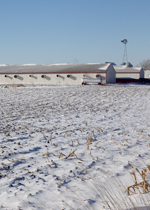 |
|
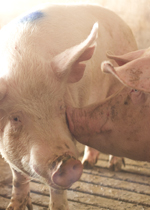 |
| Winters are snowy and cold in the Midwest. |
|
Pigs have coarse hair, not thick protective fur. |
| |
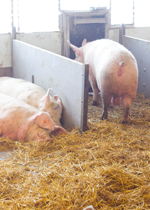 |
|
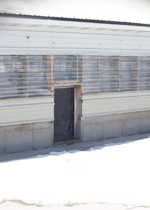 |
| The barns have special doors the pigs can open themselves. |
|
During cold wintry days, the pigs stay indoors. |
| |
|
|
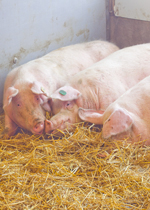 |
|
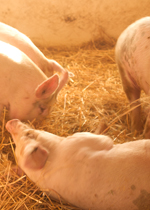 |
| Solid-floored nests stay cool in summer and warm in winter. |
|
Pigs use straw for warmth, comfort, forage, and play. |
| |
|
|
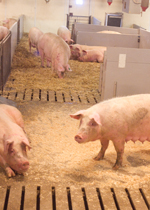 |
|
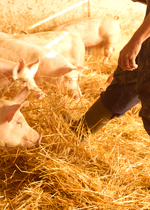 |
| Barns with slatted floors are lightly bedded, or 'dusted.' |
|
There are several inches of straw in deep bedded pens. |
|